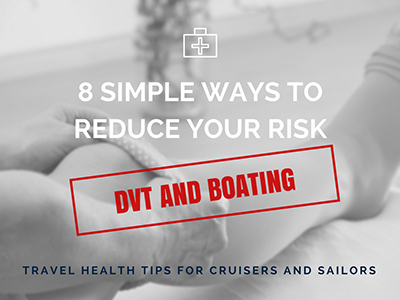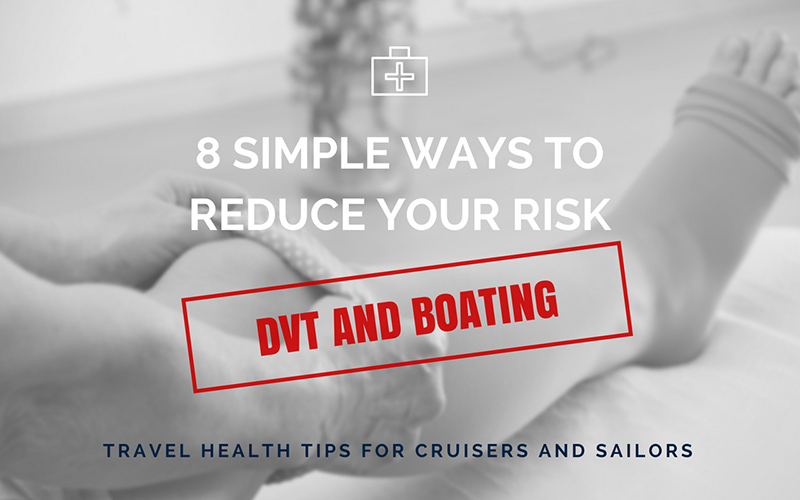

By James Chimiak, MD
TRAVEL HEALTH | Jun 21, 2018
You’ve likely heard about the link between flying and blood clots. In fact, deep vein thrombosis (DVT) has long been dubbed “economy-class syndrome” due to the cramped legs we all suffer from in this class of airline seating.
But did you know that traveling by boat can also be risky? No matter what your mode of transportation, anytime you sit still for prolonged periods of time, the blood flow in your legs slows down. This, in turn, makes your blood more likely to clot—and not just immediately. You actually remain at a higher risk for clots over the next few weeks!
Whether long-term cruising is on your docket, or you’re flying out of the country for a yacht charter or boating expedition, the good news is that you can reduce your risk of developing DVT by taking some simple precautions.
Deep vein thrombosis is the name given to a blood clot that forms in one or more of the body’s deep veins—most typically in the legs. Best case scenario: the clot will spontaneously resolve itself, and you may not feel a thing, except for some mild discomfort. The danger occurs when the clot breaks free, travels through the bloodstream, and blocks blood flow to the lungs. Without treatment, this condition, known as a pulmonary embolism (PE), can be fatal.
The Centers for Disease Control estimates that as many as 900,000 people are affected by DVT/PE each year in the U.S. alone. Some 60,000 to 100,000 don’t survive, and among those who do, roughly one-half will have long-term complications—such as swelling, pain, discoloration, and scaling in the affected limb.

The majority of people who develop travel-associated DVT have other factors that increase their likelihood of experiencing a blood clot:
DVT can often be “silent.” In fact, half of the people affected have no symptoms at all. When symptoms do occur, however, here’s what to watch for:
The risk of DVT in healthy, active people is small. Even if you are at risk, there are a number of ways you can lessen your chances of developing a blood clot while traveling:
#1 Stay hydrated.
Dehydration causes blood vessels to narrow and blood to thicken, increasing the risk for DVT. Stick with water, Gatorade, Powerade, or Pedialyte. Avoid alcohol, tea, coffee, and caffeinated sodas that cause increased urination, as this can contribute to dehydration and clots.
#2 Get moving.
Whether flying or boating, take a break every hour to stretch your legs. When you walk, the muscles of the legs squeeze the veins and move blood to the heart. After sitting for a mere 90 minutes, the blood flow in the calf drops by half, doubling the chances of developing a clot. Worse, in individuals with preexisting risk factors, for every hour spent sitting, the risk of a blood clot increases by 10 percent.
#3 Sit here when flying.
When possible, choose an exit row or bulkhead seat to increase your legroom. At the very least, select an aisle seat so it will be easier for you to get up and move around once permitted to do so.
#4 Store your luggage overhead and your gear elsewhere.
Keep the space around your feet empty so you can exercise your feet and ankles occasionally. When flying, this means clearing the area beneath the seat in front of you. When boating, this could mean stowing your lifejackets, toolkits, and first-aid supplies elsewhere on the boat. Also, recline your seat when possible to help relieve pressure points and keep blood circulating.
#5 Take your ankles for a spin.
When confined to your seat, avoid crossing your legs, since that can interfere with circulation. There are also several simple exercises you can do while seated to keep blood flowing (aim for a mini-workout every 20 – 30 minutes):
#6 Dress for comfort.
Wear loose-fitting clothing and avoid anything tight that could restrict circulation around your waist or legs. Ditch socks with tight elastic bands at the top, and always wear the comfiest shoes you own.
#7 Consider wearing compression socks (knee-high) or stockings (thigh-high).
A study in the journal Thrombosis found that people who wore compression stockings or socks were less likely to develop complications from DVT. These work by putting gentle pressure on your feet and legs to improve blood flow. You can purchase these from pharmacies, but keep in mind that compression socks or stockings do not replace the need for moving around or exercising while stuck seated.
#8 Take an Aspirin
If you’re not at risk for bleeding and can tolerate aspirin, take a baby aspirin (81 milligrams) a half-hour before flying. This over-the-counter blood thinner may help inhibit your blood’s ability to clot, thus reducing your risk of developing DVT. Some people at particularly high risk for DVT may also benefit from a heparin injection before a long-haul flight, so consult your physician before traveling long distances.
Remember, DVT is a serious medical condition that requires immediate and appropriate diagnosis and treatment to improve your chances of survival, healing, and preventing life-and-limb threatening complications. Fortunately, DAN Boater membership provides assistance with the emergency medical services you need — such as transportation to the closest hospital, getting you back home for better-quality medical treatment, and answering health-related questions — wherever in the world you may be.
About James Chimiak, MD
Dr. Chimiak is the Medical Director at DAN where he oversees the organization's emergency management and medical operations. A former U.S. Navy Special Operations, Surface Warfare and Deep Sea Diver, he is also a triple board-certified physician in hyperbaric medicine, anesthesiology, and chronic pain.
MORE FROM
SAFE PASSAGE

TRAVEL HEALTH | Aug 3, 2019
Boaters Have a New Option for Learning CPR and First Aid

TRAVEL HEALTH | Jul 2, 2019
Rare, but Deadly. What You Need to Know About Flesh-Eating Bacterial Infections
THIS WEBSITE DOES NOT PROVIDE MEDICAL OR DENTAL ADVICE.
It is intended for general informational purposes only and does not address individual circumstances. It is not a substitute for professional medical or dental advice, diagnosis or treatment and should not be relied on to make decisions about your health. Never ignore professional medical or dental advice in seeking treatment because of something you have read on the DAN Boater website. If you think you may have a medical emergency, immediately call your doctor, dial 911, or contact emergency services nearest you.